Bulletin – December 2007 Intraday Currency Market Volatility and Turnover[1]
- Download 105KB
Introduction
The global market for foreign exchange is larger in turnover than any other market, including global equities, and is typically extremely liquid. Currency markets can also be volatile. Volatility can be caused by market participants reacting to public economic and financial news, such as data releases with results that were not expected by the market or unanticipated monetary policy decisions. Currency volatility can also stem from ‘order flow’, as market participants acting on private information place orders to buy or sell foreign exchange. With well over US$3 trillion worth of transactions undertaken every day in foreign exchange markets globally, intraday movements in currencies can have significant effects on financial and economic decisions and outcomes.[2]
This article examines intraday volatility of the Australian and US dollars against a range of currencies, using high-frequency exchange rate data spanning 14 years. It finds that there is a similar pattern of intraday volatility across all the currency pairs examined, and this pattern is relatively stable over time. Volatility tends to be higher in the offshore trading session (that is, outside the Sydney trading time zone), particularly during the overlap of trading in London and New York, the two largest and most liquid foreign exchange markets. Spikes in volatility are also observed around specific times, such as major conomic data releases, the London fix (see below) and the opening and closing of regional markets.
There is also evidence that intraday volatility is positively correlated with intraday turnover. In the case of the AUD/USD, we observe significantly greater turnover in the offshore trading session than in the local trading time zone. That is, higher intraday volatility tends to be associated with higher intraday turnover and greater market liquidity for a given currency pair. One factor that can explain this is the arrival of new information, which tends to generate both volatility and turnover as market participants react to news. That said, when observing market movements at very high frequencies, there can be times where volatility is high but turnover and liquidity are low, such as in periods of market distress.
Intraday Volatility of AUD/USD
Average AUD/USD volatility was calculated for each 10-minute period of the trading day, using high-frequency exchange rate data collected for the period from 1993 to 2007 (Graph 1).[3] For each 10-minute interval, average volatility is calculated as the average absolute percentage change.[4] The vertical lines on Graph 1 depict the timing of key events. For example, official Australian economic data are released at 11.30 am.[5] The horizontal lines on the lower part of the graph indicate, in Australian Eastern Standard Time (AEST), approximately when trading sessions occur in various international markets.[6]
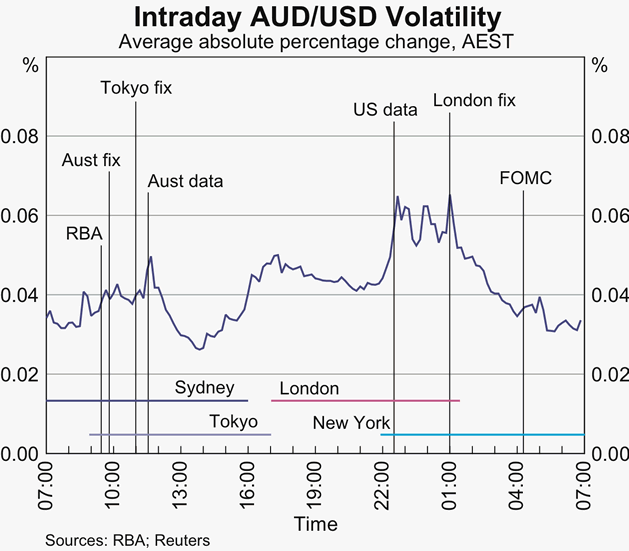
AUD/USD volatility is highest in the offshore trading session (i.e. outside of the Sydney trading time zone), in particular during the time period when both the London and New York markets are open. That is, volatility tends to be higher in the two largest and most liquid foreign exchange markets. One explanation is that news related to the US and Europe, the two largest world economies, is released during the offshore session. Another possible explanation is that the majority of global trade in commodities, the prices of which are important drivers of the Australian dollar exchange rate, occurs during the London and New York trading sessions.
There are peaks in volatility at the times of the day when most Australian and US economic data are released.[7] Given that the analysis averages volatility across all days in the sample, not just days when data releases occur, this provides strong evidence that data releases lead to higher volatility in the AUD/USD.
There is a distinct spike in volatility at the time of the London fix. The fix is where banks establish a daily exchange rate for those customers who do not want to make an active choice as to what time of day is best to buy and sell foreign currency. Non-financial corporations and fund managers often undertake their trades at the fixing rate, and it is often used in contracts that involve foreign exchange transactions or calculations. Customers intending to trade at the fixing rate must make this intention to trade known to their bank beforehand. The bank then buys or sells foreign exchange to cover these orders, using its discretion as to when to undertake these trades. As the fix is usually associated with heavy trading, market participants seeking to undertake large trades will often do so at this time. This can result in exchange rate volatility around the time of the fix. The major fixes occur in London and Tokyo, at 1 am and 11 am AEST respectively. Sydney also has a fix at 9.45am.
Spikes in volatility are also observed around the opening and closing of major markets. One example is the period when Sydney and Tokyo trading is winding down and London trading is commencing (Graph 1). Volatility can arise when traders in a given foreign exchange market close out their positions at the end of the trading day. That is, traders buy or sell currencies in order to reduce their foreign currency exposure until they return to work the following day. Similarly, as traders in a given market return to work and re-establish foreign currency positions, volatility tends to rise.
Graph 1 does not show an increase in volatility around the time of Australian or US official interest rate announcements (denoted as RBA and FOMC respectively in Graph 1). This is due to the fact that the analysis averages the level of volatility across all days in the sample. Since interest rate announcements occur relatively infrequently, the averaging process disguises their impact. Comparing days when interest rate announcements occur to all other days shows that announcements do have an effect on exchange rate volatility.[8]
Volatility is generally at its lowest during Sydney lunch time and Asian market lunch time.
Observing AUD/USD volatility over three sub-periods reveals that the overall pattern of intraday volatility has not changed materially over time (Graph 2). It is noteworthy that the average level of volatility was highest in the 1998–2001 sub-sample across almost all of the 10-minute periods of the day. This likely reflects several periods of market uncertainty within this sub-sample, including the Asian financial crisis, Russian default crisis, the collapse of the hedge fund Long Term Capital Management and the technology stock boom and bust.
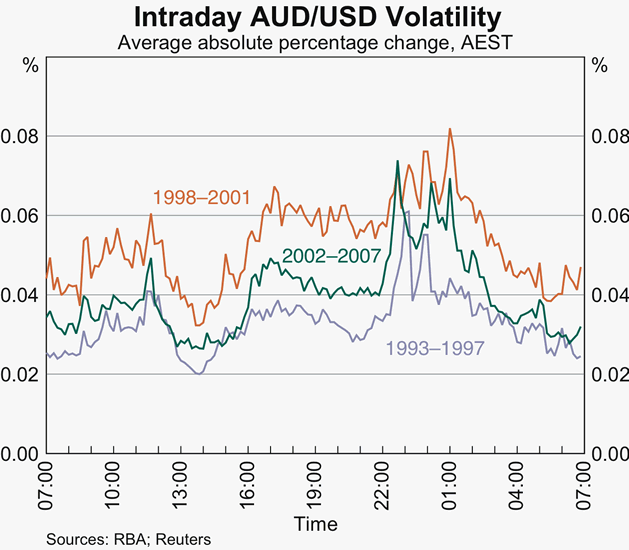
Volatility in the offshore trading session is higher than during the Sydney trading session over all three sub-samples (Table 1). However, the difference has been more pronounced in recent times, suggesting that volatility in the offshore session has become an increasingly important driver of intraday movements in the AUD/USD. This may reflect factors such as the importance of movements in the US dollar for the AUD/USD exchange rate in recent years, and significant commodity price movements, which have tended to be more pronounced in the offshore trading session, and correlated with movements in the Australian dollar.
| 1993–1997 | 1998–2001 | 2002–2007 | Full sample | |
|---|---|---|---|---|
| Sydney session | 0.029 | 0.045 | 0.033 | 0.035 |
| Offshore session | 0.035 | 0.057 | 0.043 | 0.045 |
| Ratio of Sydney to offshore | 0.82 | 0.80 | 0.77 | 0.79 |
|
Sources: RBA; Reuters |
||||
Intraday Volatility of the Australian Dollar against Other Currencies
Average intraday volatility of the Australian dollar exchange rate against the euro, Japanese yen and New Zealand dollar is shown in Graph 3.[9] For all of these cross rates the intraday pattern of volatility is broadly similar to that of the AUD/USD, with higher volatility outside the Sydney trading session. Spikes in volatility are also observed at the times of both Australian and US economic data releases and the London fix. The AUD/JPY shows a relatively large increase in volatility from around 10 am, coinciding with the open of the Tokyo stock market, followed by the Tokyo fix at 11 am.
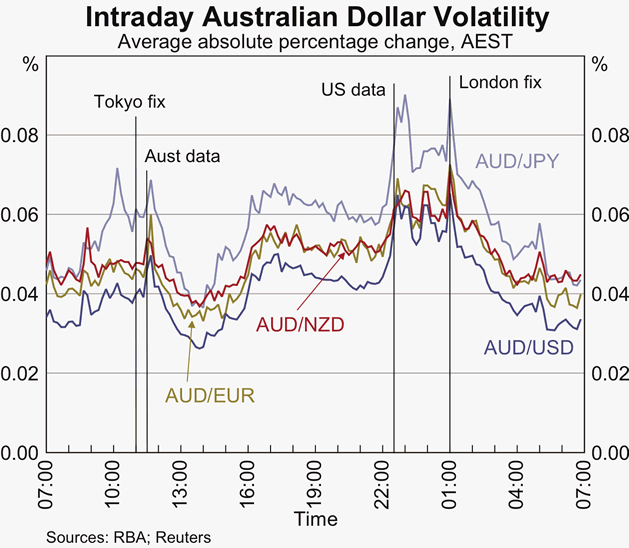
Similar to the AUD/USD, the other Australian dollar cross rates show the highest average intraday volatility in the 1998–2001 sub-sample (Graphs 4–6). For the AUD/JPY, volatility is generally lowest in the 2002–2007 sub-sample. This may be partly attributable to stable market expectations of Japanese official interest rates over much of this period. Like the AUD/USD, the AUD/NZD shows the lowest volatility in the period prior to 1998, although volatility since 2002 has also been low.
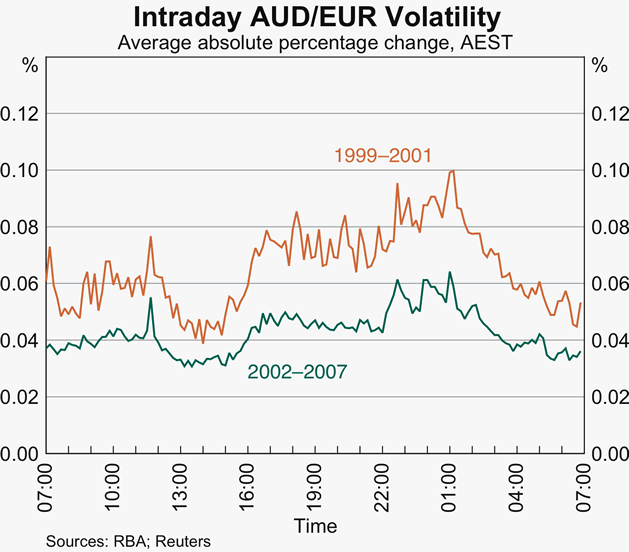
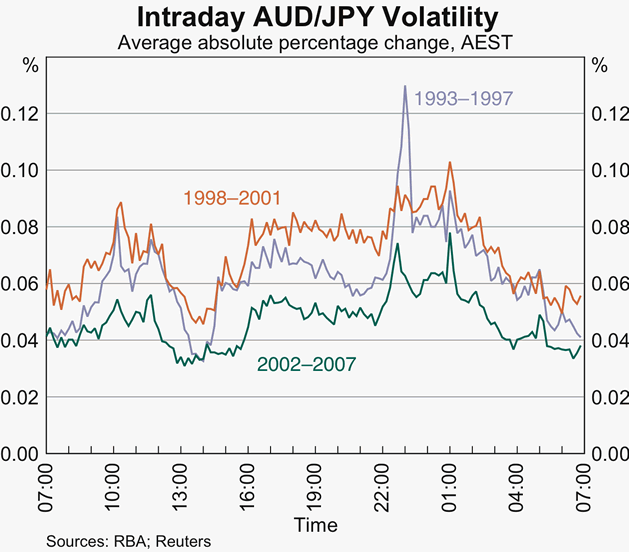
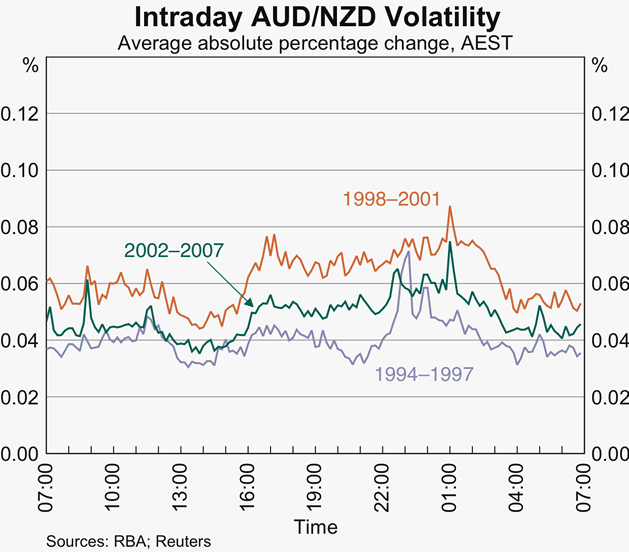
Intraday Volatility of US Dollar Exchange Rates
The average intraday patterns of volatility for the US dollar exchange rate against the euro, Japanese yen, Canadian dollar and New Zealand dollar are similar to those for the Australian dollar exchange rates described above (Graph 7).[10] We find that all the currency pairings show spikes in volatility at the time of the London fix and the release of US economic data. Volatility is also highest during the overlap of London and New York trading.
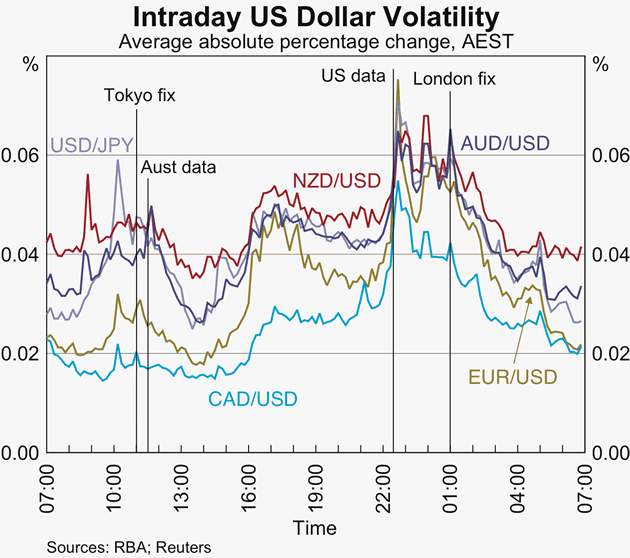
There is a spike in volatility across each of the currency pairings, but particularly the USD/JPY, at around 10 am, coinciding with the opening of the Tokyo stock exchange. The NZD/USD shows a spike in volatility corresponding to the release of NZ economic data (released at 8.45 am AEST).
Similar to the Australian dollar cross rates, the exchange rates against the US dollar generally show higher volatility in the 1998–2001 sub-sample (see Graphs 8–11). The exception is the CAD/USD, which experienced higher volatility in the most recent sub-sample. The EUR/USD and USD/JPY show the lowest volatility in the 2002–2007 sub-sample. Likely reflecting relatively low volatility in commodity prices, the CAD/USD and NZD/USD, like the AUD/USD, were least volatile in the sub-sample prior to 1997.
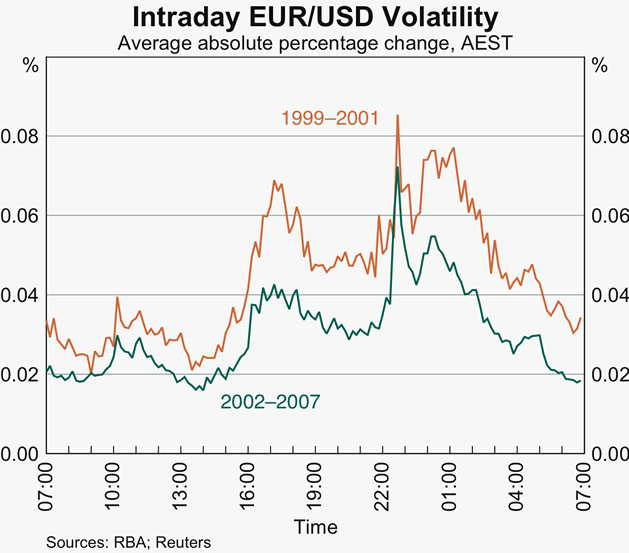
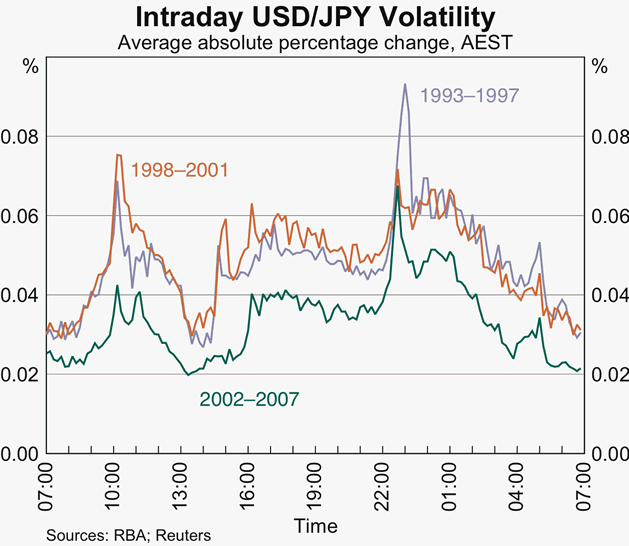
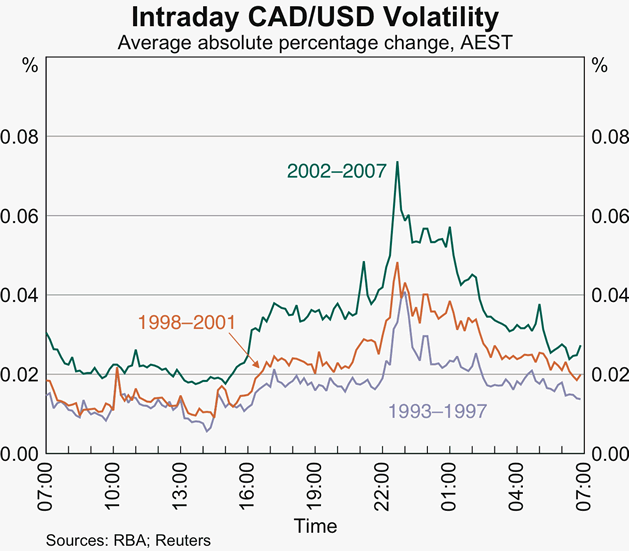
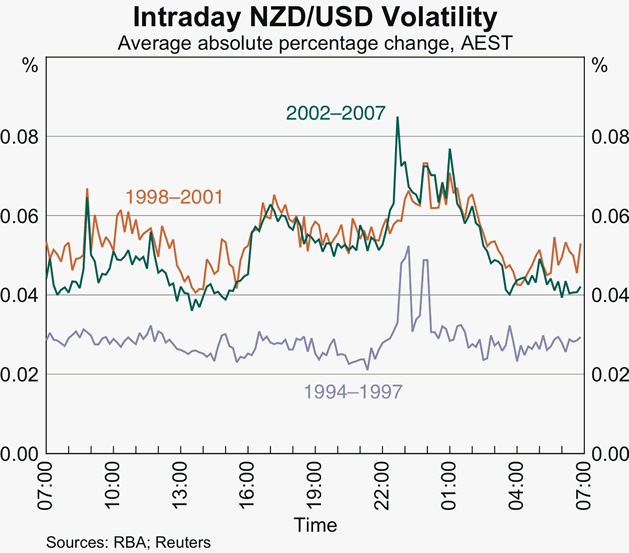
Intraday Turnover in Currencies
Intraday foreign exchange turnover reflects factors such as the flow of news and customer orders. Analysis of intraday turnover in the foreign exchange spot market reveals similar patterns to intraday volatility across a range of currency pairs. That is, higher turnover tends to be correlated with higher volatility over the day.
Hourly turnover data were obtained from Reuters over a three-and-a-half-month period, and measure the number of trades that occurred globally in the spot market through electronic broking systems.[11] While there is no information on the proportion of global turnover that occurs through electronic broking systems, the US Foreign Exchange Committee reported that 30 per cent of North American spot market turnover was executed through electronic broking systems in April 2007, and the spot market accounted for around half of total traditional turnover in the US market.[12]
Average intraday spot market turnover of AUD/USD and various other USD cross rates are shown in Graph 12. In the Sydney trading session, which overlaps with several Asian sessions, the USD/JPY recorded the most turnover, followed by the AUD/USD and then the EUR/USD. In the offshore trading session, average turnover in the EUR/USD and the USD/JPY was the highest of the currency pairs considered, followed by the AUD/USD, CAD/USD and NZD/USD.
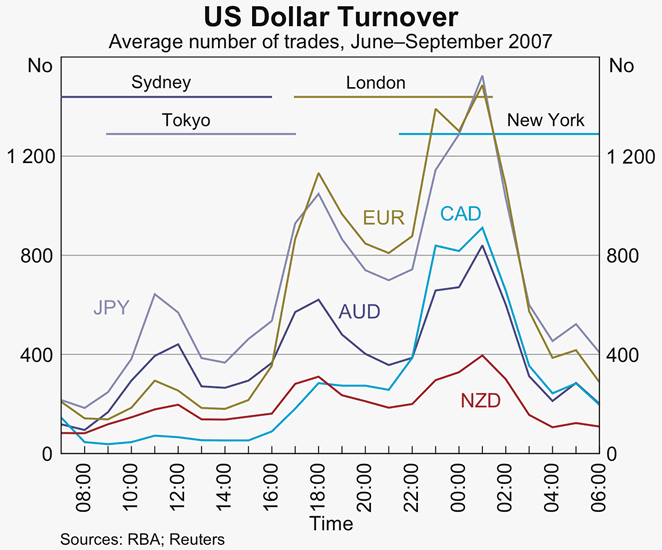
As with volatility, the AUD/USD, USD/JPY and NZD/USD have a relatively higher proportion of turnover during the Sydney trading time zone (reflected by a flatter profile in Graph 12), compared with the EUR/USD and CAD/USD. The relatively uneven distribution of trading is particularly notable for the CAD/USD, in which the large majority of turnover occurs in the North American trading session.
The Relationship between Intraday Volatility and Turnover
The profile of turnover across the day is similar to the intraday patterns in volatility (Graphs 13–15).[13] That is, turnover is highest during the offshore session, particularly during the overlap of the London and New York trading sessions. There are also peaks in turnover around the time of Australian economic and US data releases, the opening of Asian markets, and the opening of London and European markets.
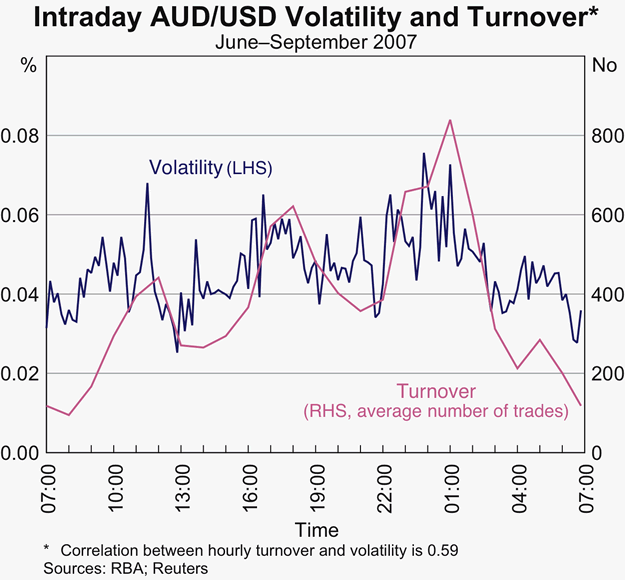
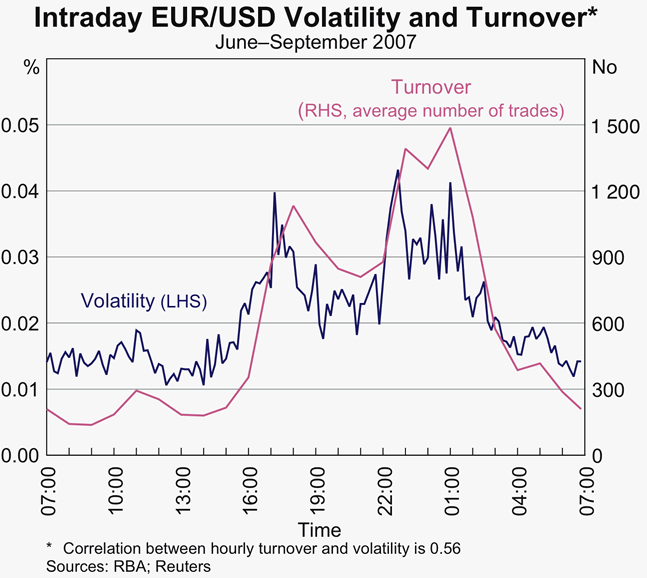
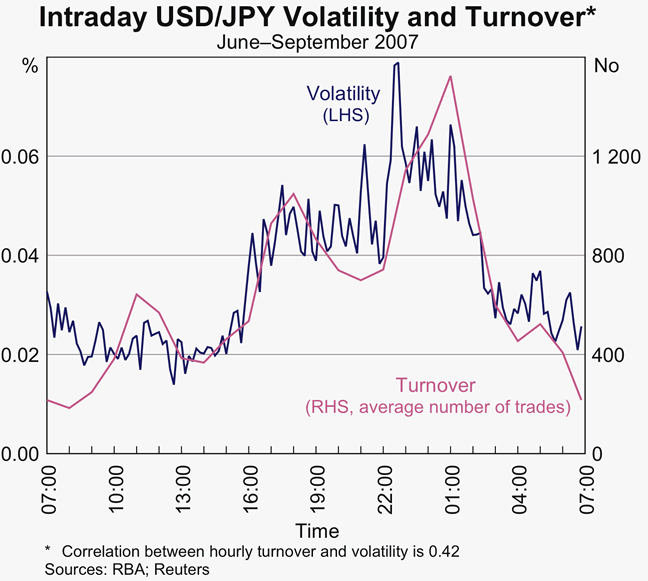
These results suggest that higher intraday volatility tends to be associated with higher intraday turnover and more liquid markets. One factor that can explain this is the arrival of new information, which generates volatility as the market responds. For example, if the majority of market participants thought that new information would be likely to lead to an appreciation of the AUD/USD, they would seek to buy AUD/USD. This would place upward pressure on the currency, as there would now be more people willing to buy at a higher exchange rate than before the release of the new information. As the currency appreciates, these new orders to buy at a higher exchange rate are matched by orders to sell. The execution of these trades at the higher exchange rate presents as an increase in turnover. Hence, as new information is released, market participants seek to rebalance their portfolios by either offering to buy or sell the currency at specified rates. As these bids and offers are matched and trades are executed, the currency moves and both volatility and turnover increase.
However, when observing market movements at very high frequencies, there can be times where volatility is high but turnover and liquidity are low, such as in periods of market distress. For example, the turmoil in global credit markets that began in August 2007 brought about a reduction in investors' risk appetite, which initiated an unwinding of carry trades and a sharp depreciation in currencies such as AUD/USD and NZD/USD. Market reports described conditions as extremely illiquid. With the vast majority of market participants looking to sell AUD/USD, the currency depreciated. Volatility increased, but there were still few buyers in the market, so turnover and liquidity were low. As the exchange rate continued to depreciate, more buyers eventually came into the market, turnover increased and liquidity improved. The positive relationship between volatility and turnover, usually associated with higher liquidity, was eventually restored by a significant move in the exchange rate in one direction.
Conclusion
This article examines the intraday volatility and turnover of the Australian and US dollars against a range of currencies. One of the main findings is that different currency pairings share the same broad patterns in volatility over the day. Volatility is highest on average outside of the Sydney trading time zone, particularly during the overlap of the London and New York trading sessions. That is, volatility tends to be higher in the most liquid markets. This is likely due to the fact that the majority of economic news related to the US and Europe, the world's largest economies, as well as most of the global trade in commodities markets, occurs during these sessions. The analysis also highlights that the increase in both volatility and turnover associated with key events is short-lived, as evidenced by spikes in the data around the time of events such as regularly scheduled US economic data releases.
While the broad patterns in volatility are similar for all the currencies we examine, we find that the Australian dollar, New Zealand dollar and Japanese yen exhibit relatively higher volatility than do the euro and Canadian dollar in the Sydney trading session. This is consistent with the fact that economic news directly relevant to Australia, New Zealand and Japan is primarily released during the Asia-Pacific trading session, while Canadian and European economic news is released outside of this session. Finally, we examine intraday patterns in spot turnover between dealers, and find a positive relationship between intraday currency volatility and the level of turnover.
Footnotes
This article was prepared by Kristina Clifton and Michael Plumb of International Department. [1]
Triennial Central Bank Survey of Foreign Exchange and Derivatives Market Activity in April 2007 – Preliminary Global Results, available at<http://www.bis.org/triennial.htm>. [2]
The data were collected to 29 September 2007. [3]
Exchange rate data are from Reuters, a financial data service provider and news service. Results are not sensitive to the use of alternative volatility measures, such as the standard deviation. [4]
Given that the timing of offshore events will vary in Australian time depending on daylight saving, results were calculated separately for Australian Eastern Standard Time (AEST) and daylight saving time. As the general results remain the same, results are only presented for AEST. [5]
Trading session times are indicative only, as foreign exchange markets have no official open and close times. It is assumed that the Sydney trading session commences at the end of the New York session (7 am AEST, or 5 pm in New York the previous day). For all other markets, the trading session is assumed to begin at 8 am in their local time zone, and close at 4 pm in their local time zone. Other major foreign exchange markets, not indicated in Graph 1, include Zurich, Singapore, Hong Kong and Frankfurt. [6]
The majority of US economic data are released at 10.30pm AEST, with other regular data releases occurring at 11.15 pm, 11.45 pm and midnight AEST. [7]
See Kearns J and P Manners (2006), ‘The Impact of Monetary Policy on the Exchange Rate: A Study Using Intraday Data’, International Journal of Central Banking, 2(4), pp 157–183. [8]
Data for AUD/EUR commence in 1999 and for AUD/NZD in 1994. [9]
These results are consistent with Baillie R and T Bollerslev (1990), ‘Intraday and Inter-Market Volatility in Foreign Exchange Rates’, Review of Economic Studies, 58(3), pp 565–585. The currencies examined were the yen, deutsche mark, British pound and Swiss franc vis-à-vis the US dollar, and the yen, deutsche mark and Swiss franc vis-à-vis the British pound. [10]
The two predominant wholesale electronic broking systems in the foreign exchange market are Reuters Dealing Spot Matching and ICAP-EBS. For the AUD/USD, CAD/USD, NZD/USD and AUD/NZD, data were collected from the Reuters Dealing Spot Matching system, as the majority of electronic inter-dealer trading in these currencies occurs on this platform. For the EUR/USD and USD/JPY, data were collected from the ICAP-EBS system, which accounts for the majority of electronic inter-dealer trading in these currencies. The data were collected from 15 June 2007 to 29 September 2007. [11]
Survey of North American Foreign Exchange Volume – April 2007, US Foreign Exchange Committee, available at <http://www.newyorkfed.org/fxc/volumesurvey/> Includes US, Canada and Mexico. [12]
This is consistent with the findings of previous studies, including Bjønnes GH, D Rime and HOAa Solheim (2003), ‘Volume, Order Flow and the FX Market: Does It Matter Who You Are?’, Norges Bank Working Paper No 2003/7, which find a positive relationship between the volume of trade and volatility in the SEK/EUR. [13]